
This article originally appeared in the November/December 2022 issue of Museum magazine, a benefit of AAM membership.
Using media and technology in exhibition design leads to wider and deeper audience engagement.
The global coronavirus pandemic has been a disruption like none other. Initially, it spared no sector of the global economy, and museums were hit hard. However, our digital infrastructure and information communication technologies were a saving grace that allowed people to remain connected, share, socialize, and conduct some manner of business.
A forest burned down creates fertile soil for regrowth, and out of any disruption comes great opportunity for change. It is up to us, as museum professionals, geeks, and fans, to take advantage of this opportunity and not regress to the way things were.
When museums closed in 2020, they scrambled to offer remote programming. Out of necessity, both museum professionals and audiences ended up increasing their digital literacy. Meanwhile, it became clear that organizations with more mature and dynamic digital infrastructures and teams were better able to pivot. Both of these facts reveal some of the opportunity that now exists for museums to provide exhibitions and programming that use media and technology to engage more people in more ways.
Beyond Just the Physical
My approach to exhibition design and development has always privileged a blended experience that considers how to engage both on-site and remote audiences concurrently and how to facilitate discourse between and among audience types. I honed my approach during my tenure at the Canadian Museum for Human Rights (CMHR), where I considered it a necessity.
The CMHR, a national museum located in a remote city with a population under 800,000, deals with an international subject matter. It seemed to me that exhibitions needed to do more than just rely on physical visitation to engage in national and international discourse. I laid out the following prerequisites for my teams and collaborators:
- Ensure that the design is inclusive, which considers all vectors of human difference at the outset versus designing something and then determining how to make it accessible.
- Provide a number of entry points to content and experience through mixed and transmedia, congruent yet stylistic differences (photographic, illustrative, realistic, metaphoric, etc.), and mixed interaction design scenarios (passive, active, interactive).
- Offer both in situ and remote participation to not only engage larger audiences but for prolonged visitor engagement as well.
Notably, these prerequisites work well in concert with one another. For example, ensuring exhibitions welcome and engage the widest possible audiences irrespective of ability-disability means audience members who might never make it to the museum can also participate.
Additionally, these prerequisites were designed to yield strategic returns across the museum’s performance metrics: greater audience reach, prolonged audience engagement, increased diversity of audience demographics, greater visitation, greater active participation and collaboration, greater earned revenue, and more informed programming through a greater plurality of perspectives. This approach proved more successful than originally anticipated. For example, an exhibition with no promotion budget garnered $8 million in earned media and an exhibition’s video game activity saw more activity online than from visitors at the museum.
Blended Design in Action
The following examples of blended design highlight the various ways I used media and technology to satisfy my prerequisites and realize greater strategic returns. These opportunities persist today, and given the advancement in digital literacy and the downside of not approaching program design in this manner, I hope this blended experience approach will become more the norm than the exception across the sector.
The ‘Witness Blanket’ Exhibition
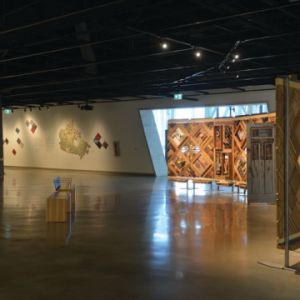
facilitated an interactive experience where visitors could
express their reflection about the “Witness Blanket” while
remote audiences could participate via a web interface.
The “Witness Blanket” is a mixed-media installation created by master carver Carey Newman. It is an assemblage of found objects from the sites of Canadian Residential Schools installed and integrated into a large series of panels. These boarding schools, administered by Christian churches and funded by the Canadian government, were used to assimilate Indigenous children and are now rightfully acknowledged as a part of the colonial genocide of Canada’s Indigenous peoples. It is an incredibly moving installation.
I wanted to take the passive experience and make it interactive while also enabling remote audiences to explore the blanket and participate. The solution involved creating a digital interface (similar to a simple web page form) that visitors in the gallery could access via iPads and online visitors could access via their web browser. The interface accompanied a high-resolution image of the blanket and detailed visual descriptions.
Once visitors explored the blanket, they could express a reflection (such as “reconciliation,” “peace,” or “genocide”) via the digital interfaces. Their reflections were aggregated and projected across the blanket in the gallery and on an accompanying web page. The more often a sentiment was expressed, the larger it appeared in the collage of words. This intervention blended the experience, making it passive and interactive, analog and digital, remote and in situ. Had the museum closed during the run of this exhibition, the dialogue on colonization and Indigenous genocide that the exhibition was facilitating would have persisted.
‘Mandela: Struggle for Freedom’ Exhibition
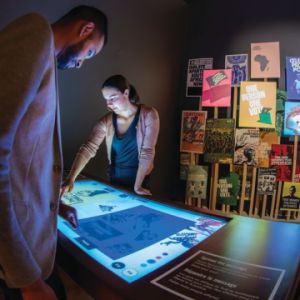
“Mandela: Struggle for Freedom” looks at Nelson Mandela and the movement that formed around him in South Africa, following his journey into hiding after he was declared an outlaw, his 27-year-long prison life, and his role in the country post-release. This exhibition demonstrates that any one individual can make a difference. Visitors learn about Apartheid and the global movement to end it, the approach and outcomes of South Africa’s first democratic elections, and Mandela’s efforts to rebuild a nation shattered by racism and injustice.
The design of the Soweto uprising portion of the exhibition forces the visitor into a narrow space with the silhouettes of the people protesting on one side and silhouettes of the militarized police force on the other. Visitors can handle replica garbage can lids on the protestors’ side, while a full-scale Casspir tank section sits on the other side. Both sides of the installation were created to emphasize scale and space with multimodal (visual, audio, and tactile) accessibility affordances.
At the Posters for Freedom installation at the end of this section of the exhibition, visitors can create their own protest posters, like those from the uprising. Their posters are then projected onto one of three blank protest signs set in a collection of signs re-created for the exhibition. Remote participants can develop their own posters at PosterForFreedom.ca and have them projected in the gallery. All posters, whether created in the gallery or online, are available at this website. Even when the exhibition is between venues, educators can have their students create protest posters and know they will appear not only online but in gallery wherever the exhibition is next presented.
‘Sight Unseen’ Exhibition
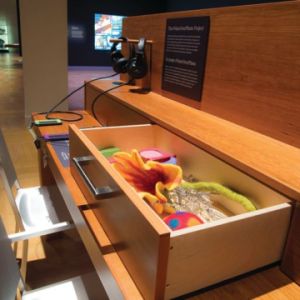
In the “Sight Unseen” exhibition, a photography show, all the work was created by photographers who are blind, challenging visitors’ preconceived opinions about “perception.” Not only was I intrigued by how we might interpret this within a human rights context, but I was equally excited by the exhibition design potential.
I wanted to push the inclusion and accessibility of this show while making a passive exhibition (2-D artwork) both active and interactive. We did this a number of ways, including translating photos to tactile relief, providing audio-described images, and enabling visitors to create their own tactile images through a facilitated station.
We also challenged visitors to use an iPod Touch device with the screen turned off to take photos using the accessibility features inherent to the device. The resulting images were hashtagged and posted to Instagram and aggregated into a Tumblr page. This page was then projected in the gallery, within the context of the exhibition, democratizing the content presentation in a fine art exhibition. The accompanying social media campaign encouraged anyone to participate in the challenge using their own devices, and thousands of photos were contributed by people who never visited the exhibition in person.
‘Stitching Our Struggles’ Installation
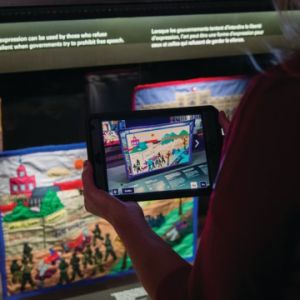
Arpilleras are patchwork textiles that were made and used in Chile during Augusto Pinochet’s military dictatorship to denounce the regime’s human rights and civil liberties abuses. These rich textiles were presented under low-lighting conditions in environmentally sensitive cases that strictly control humidity and temperature. The typical limits of physical exhibition design also meant that interpretive content was minimal due to the practical constraints of label sizing.
Using augmented reality, I wanted to increase detailed artifact exploration, extend the experience to remote audiences, provide supplemental content and interpretation, and increase the artifacts’ accessibility for audience members who were blind or low vision. We provided supplemental audio, video, and text through hotspot buttons that when clicked provided a guided audio tour of the artifacts and their details. Visitors could use iPads installed in the gallery or download the Stitching Our Struggles app on their own devices.
The same image recognition technology that launched the AR content in the gallery could also work with any image of the arpilleras. Therefore, educators could use the app in classrooms, visitors could revisit the content at home, or those who never made it to the museum could explore these important stories just as thoroughly as visitors in the gallery. Visitors who otherwise would not have been able to see the artifacts could view them through an iPad display and could zoom in, adjust screen brightness, access visual descriptions, and navigate the artifacts via text-to-speech.
Building on What We’ve Learned
While I have focused on exhibitions, the same tactics and thinking apply to education, public programming, and events. Over the course of the pandemic, countless conferences, symposia, conventions, and meet-ups went online out of necessity. Media and technology can continue to facilitate blended events, opening museum programming to wider audiences, including those who are geographically distant or might otherwise face barriers to participation.
Blended programming provides a greater return on a museum’s investment and insulates this investment against unexpected global events while pluralizing, diversifying, and ultimately engaging more people in ways that are meaningful, relevant, and accessible to them.
Tips on Creating Blended Experiences
- Establish your curatorial, interpretive, and design intentions. Then think about how these intentions can be realized through various media (built, static, digital, audio/video) and strive for a blend of media types.
- Ensure the experience design is not overly passive (read, watch, listen) nor overly active or interactive (getting visitors to constantly perform a task).
- Consider the opportunities that digital media/technology can play in extending the project to remote audiences. Note which of these design media/technology tactics can both increase remote access and increase inclusive design and accessibility for all persons irrespective of ability/disability.
- Include digital designers in the concept, schematic, and design development processes, and make them a part of the exhibition core team.
- Understand the licensing and rights implications of your content (ensuring that it allows remote audience engagement).





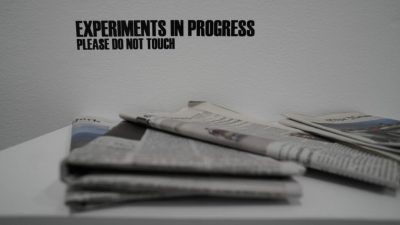
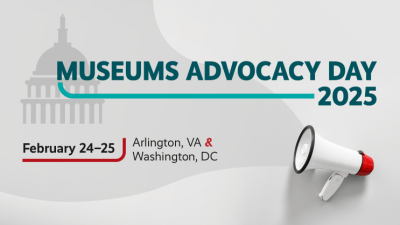
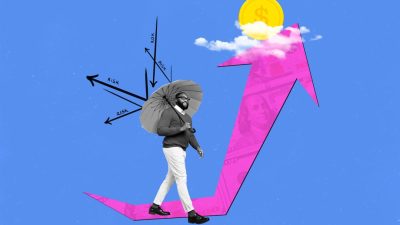
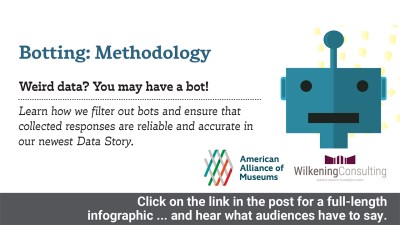
Comments